The lapping waves and silent dunes of the Delaware Bay shoreline create a perfect backdrop for a moonlit summer stroll. But a few weeks ago, this beach was not nearly so quiet. Instead, the silver light of the full moon shone upon jostling crowds of horseshoe crabs.
“If the crabs were rocks,” says Moses Katkowski, marine conservation coordinator with The Nature Conservancy, “you could walk on their backs the entire stretch of beach and never touch the sand.”
Every year, they emerge from the depths for one reason and one reason only: sex.
Lots and lots of sex.
Long before Roman emperors threw outlandish orgies, horseshoe crabs — contemporaries of the first sharks, wooly mammoths, and now us — have been making annual migrations to the shore to forge their next generation.
Truth is, horseshoe crabs haven’t changed much over their time on Earth. The four living species today look much the same as their ancestors did nearly 400 million years ago. It’s likely they reproduce just like them, too. Which means horseshoe crabs may hold the record for longest-running sex parties on the planet.
But They’re Not Really Crabs at All
Distant relatives of true crabs, horseshoe crabs aren’t really crabs at all.
Flip over a horseshoe crab and the undercarriage-view of its six paired appendages reveals the resemblance of horseshoe crabs to their closest cousins: scorpions and extinct trilobites.
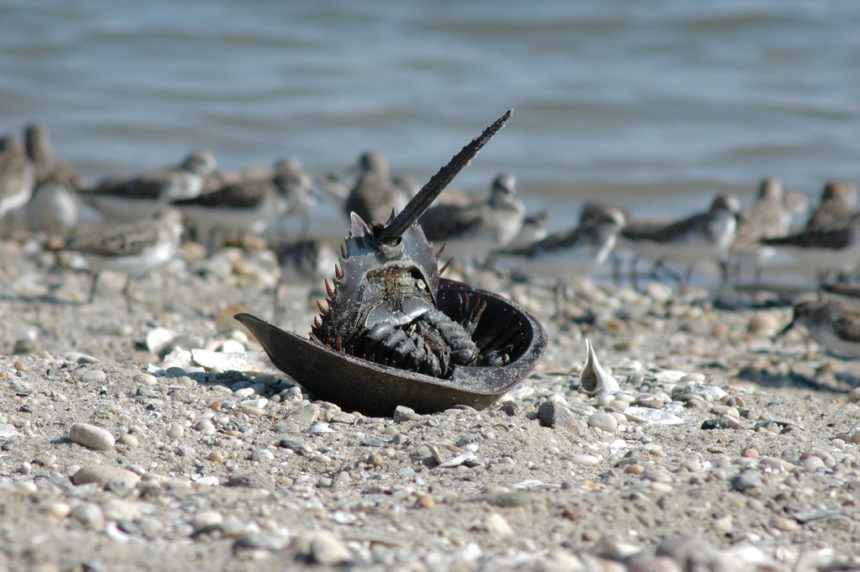
The first pair of appendages is used for eating; the next four pairs are used for walking and each appendage ends in a small pincher-like claw that doesn’t pinch.
In males, the first pair of walking appendages is modified to aid in grasping the edges of a female’s shell. (More on that in a minute.) The last pair are “pushers,” which aid the crab in locomotion.
Male horseshoe crabs arrive just ahead of the females, forming a shifting boulder field that females must plow their way through to reach suitable nesting sites along the high-tide line. As they make their way, the smaller but determined males swarm the females, shoving and sliding, until one male can successfully grab onto her shell with his front legs and pull himself aboard.
A small notch at the front of the male’s helmet-like head can then latch onto the ridges on the female’s back. In this way, the two shells sort of fit together, like a tongue-and-groove joint.
But one attached male doesn’t dissuade others from attempting to climb on, too. And if they can’t get a hold on her, they just hang on to the dude in front. In this manner a female may drag along a chain-of-suitors to the shore.
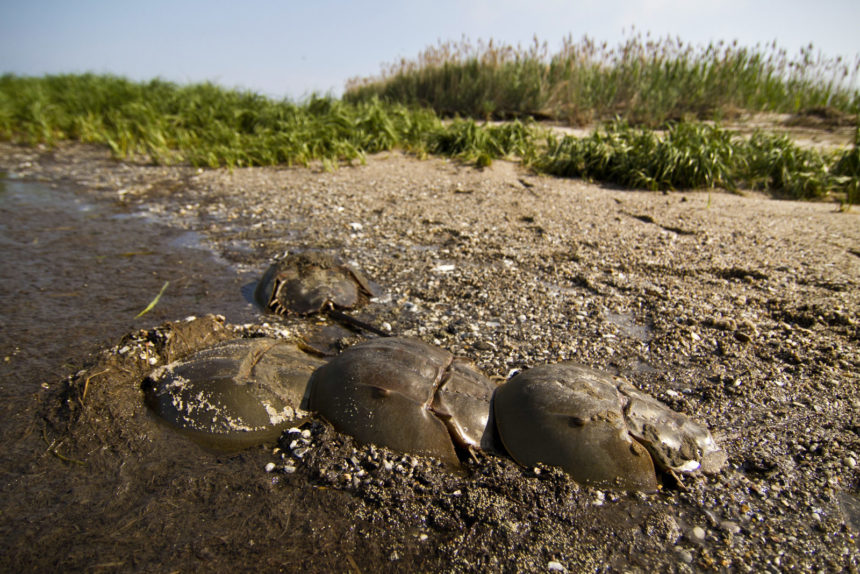
For female horseshoe crabs, reproduction takes a bit of grit.
Once she reaches the wet sand, she digs a shallow nest and proceeds to lay a batch of several million eggs, which are immediately fertilized by the surrounding males.
Horseshoe Crabs and The Nature Conservancy
A stronghold of horseshoe crab mating, Delaware Bay is the site of active research to collect census data on the local — and threatened — species, Limulus polyphemus. The arrival of thousands of individual crabs every May and June gives scientists a rare but critical glimpse into population numbers, sex ratios, and other statistics needed for better management.
As Patty Doerr, director of coastal and marine programs from The Nature Conservancy in New Jersey explains, “We need to be getting as much science to go into the management as possible. The decisions we make are only as good as the science that goes into them.”
This is why, during the full and new moons of late spring, the Conservancy joins with partner organizations to lead volunteers in conducting nighttime beach surveys of the frolicking horseshoe crabs.
Data collected from the spawning census is combined with data from offshore trawl surveys and harvest numbers to inform fisheries models run by the Atlantic State Fisheries Commission. Based on these models, the commission then sets the limit on how many horseshoe crabs can be caught.
Every year, horseshoe crabs emerge from the depths for one reason and one reason only: sex.
@marahh2o
The crab counts offer a chance for citizen scientists to witness an extraordinary cycle of life while contributing valuable data to help boost the sex life of one of nature’s most ancient mariners.
“It’s a really unique thing to see,” notes Katkowski, “Everyone has been to the beach, but 99 percent of the time you are not seeing this. But when you participate in a crab count, you are heading out at night, and there they are. Thousands of them.”
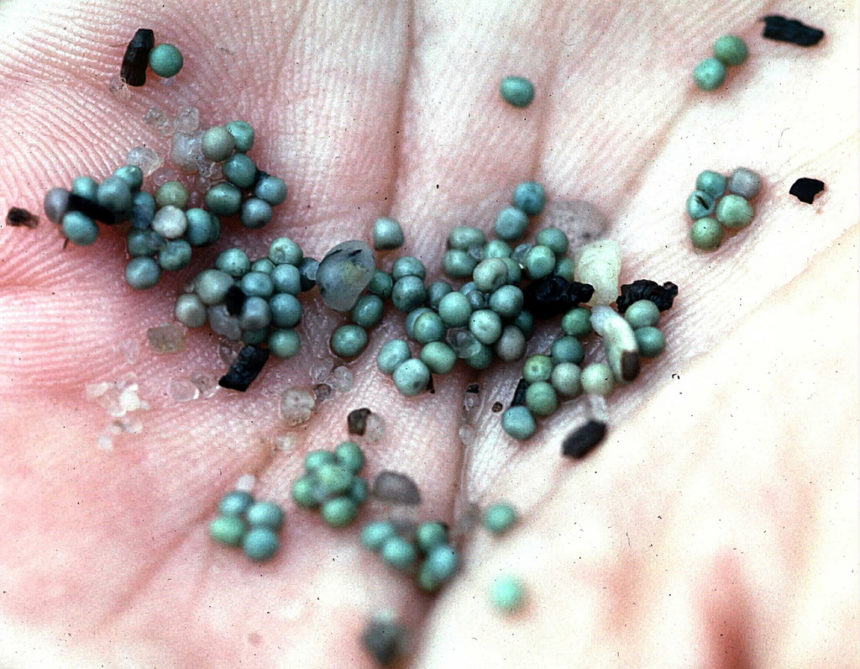
The beach itself turns mossy-green — colored by the billions of glimmering eggs laid by the female. Though much of this precious cargo remains safely buried beneath the sand, the bustling crowds of horseshoe crabs do churn things up. Smaller than a pencil eraser, these tiny spheres are everywhere — a critical link for survival. And not just for the horseshoe crab.
The Horseshoe Crab Egg Buffet
The endangered seabird species, the Red Knot, depends on the bountiful, nutritious eggs to refuel during its long migration from Tierra Del Fuego to the Canadian Arctic, a distance of more than 9,000 miles.
Using long slender beaks to slurp up the eggs during layovers, the birds time their migration to coincide with this free all-you-can-eat-horseshoe-crab-egg buffet.
As Moses notes, “You can see the crabs, see them spawning, and see the eggs. You can see the whole cycle and, if you go out, you see the birds, too.”
It’s a rare chance to witness how the sex life of a marine species supports the reproduction of life above the surface.
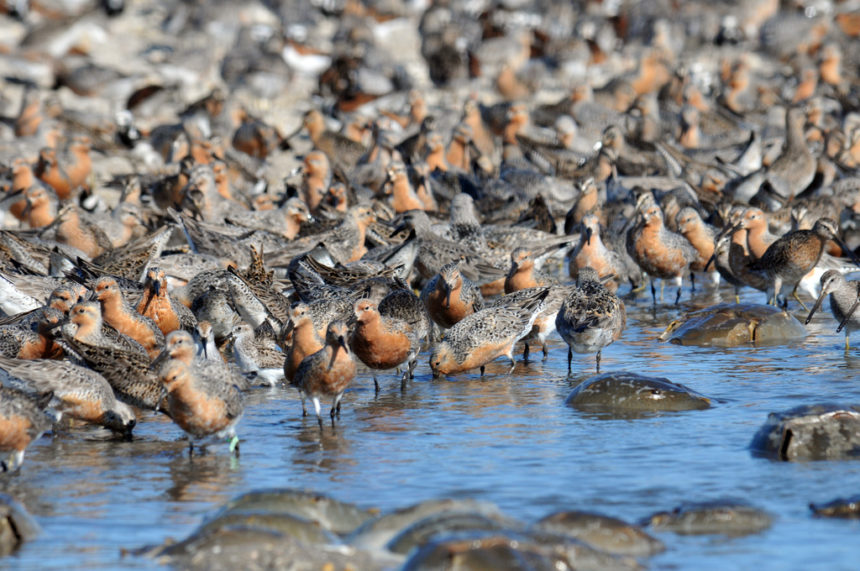
Horseshoe Crab Blood Super Powers
Healthy horseshoe crab populations are something we all need. And like the Red Knot, humans have become highly dependent upon horseshoe crabs — not for food, but for their role in biomedical safety.
Anyone out there with an artificial hip, a replaced knee, a pin holding a broken ankle, owes their device’s safe use to the horseshoe crab. Or more precisely, their blood.
Horseshoe crab blood is a marvel, not just for its powder blue color but for its remarkable capacity to detect even the tiniest trace of bacterial contamination — up to one part per trillion. This amazing fluid is our only way of ensuring that everything from implants to serums is safe for injection into our own bodies. Thus, today, we have a fleet of trained horseshoe crab phlebotomists who every year harvest crabs and then, in a move that would send even Dracula squirming, drain their blood.
Although only a portion of each crab’s blood is removed, some recent studies show that the crabs may not be surviving the process, or if they do survive, they may not feel up to mating that same season.
This potential impact only contributes to a suite of threats that have pushed horseshoe crab populations down by more than 90 percent from their historic numbers. Overfishing (horseshoe crabs are also a popular bait source for whelk and eel fisheries) and habitat loss are the other leading causes of declines.
The good news is management actions in 2004 and 2006 seem to have helped populations level off. Given that horseshoe crabs don’t mature until they are about 10 years old, it’s not surprising that we haven’t seen a rebound yet … but it’s something the Conservancy continues to look for in the census data — data they’re analyzing now as this year’s horseshoe crabs head out to deeper waters and humans head in to the local beach.
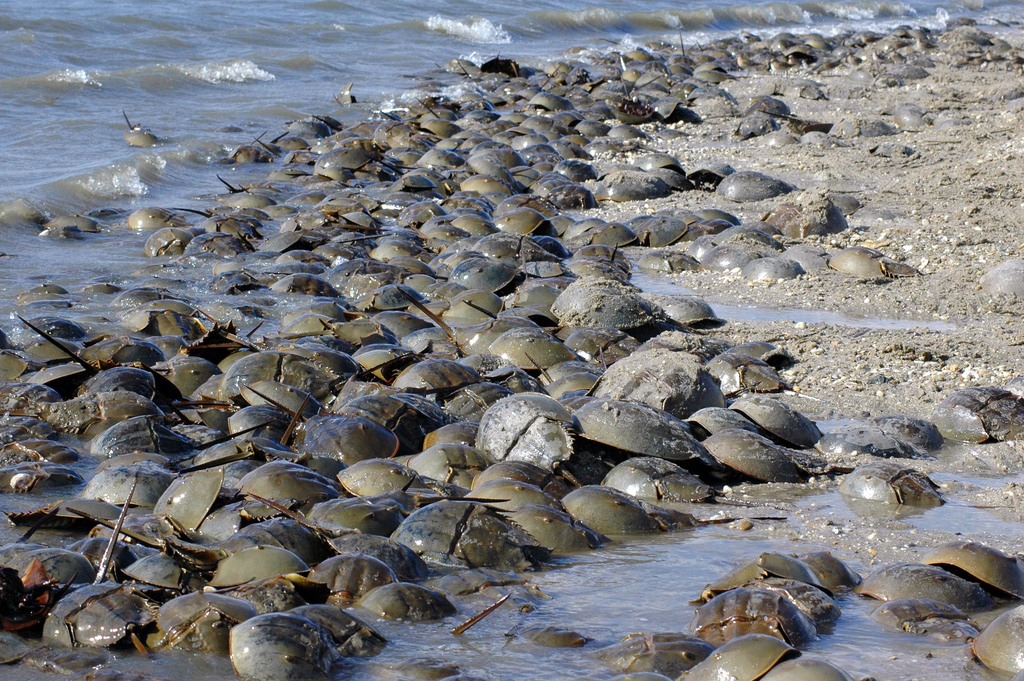



Why does the one photo say not to flip them over?
I Was Stationed at Dover Air Force Base from 79-81 & while there A Big Fuss was made about the Horseshoe crabs behind the Base at the Bay!! Being from Long IsLand & used to seeing them,I was Very Curious what the big Stink was!! So I Drove to the Bay & was Flabbergasted as Far as I could see was Mounds of Crabs 2 Feet HIGH X 6-8 Feet along the high tide line!!! IT took weeks to Clean them up! They Ended up plowing them into Farmers Fields!
The blood possibly has an overall charge, elemental copper does have an overall charge of 2+ and marine bacteria is mostly gram. negative. Therefore initiating a cascade reaction to a bacterial pathogen based on polarization and not an antigen antibody response just a guess
We used to watch hundreds of horseshoe crabs come to shore at Port St. Joe State Park in Florida. Isn’t there a connection with the full moon?
Would be wise then in considering habitat protection and preservation as a priority. What’s the EPA’s stance and how far are they prepared to assist?
That is a great question. I am not sure that the EPA would see this as an issue. I am no expert by any means, but would image that if the numbers of Horseshoe crabs are still within the 100,000 range, there is little concern to the EPA, as is the case as I understand it with other species that are a keystone species.
I am curious if there are any Environmental Educators out there who might have some light to shed on this topic?